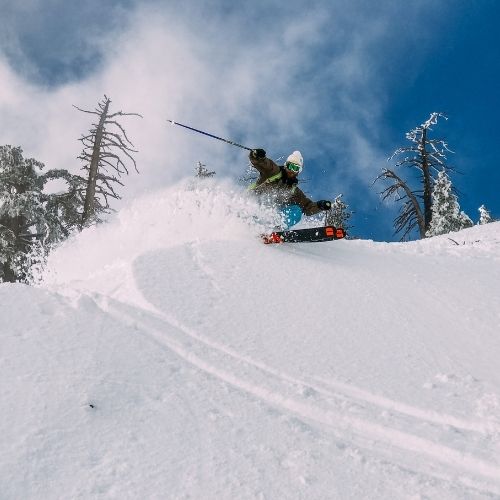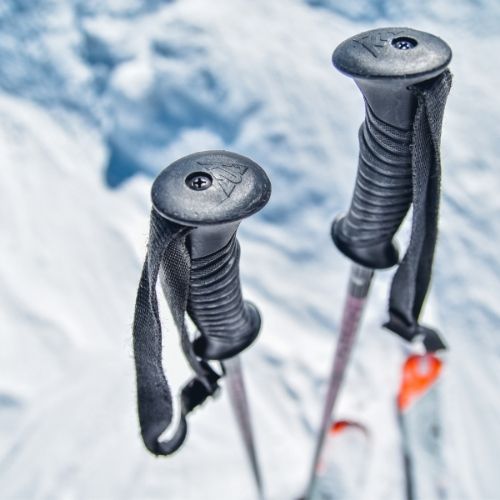We may get commissions for purchases made through links in this post. Thanks for the support! 👍
The feeling of floating through untouched powder is unmatched and is the holy grail for most skiers and snowboarders. Not waiting in lift lines, being away from the crowds, and immersed in nature are just some of the things that attract skiers and snowboarders to the backcountry.
However, this is not something that can be taken lightly, as there are many dangers hidden in this wintery paradise.

No matter how you get into the backcountry, whether under your own steam, by helicopter or snowmobile, you are venturing into uncontrolled territory. Therefore you must be armed with the right equipment and knowledge to stay as safe as possible.
In this post, we are going to answer the question of what is backcountry skiing? And we will tell you everything you need to know to get started.
What Is Backcountry Skiing?
Backcountry skiing is heading away from the marked slopes and the lift system. The idea is to ski and snowboard fresh untouched powder snow. If you have never skied or snowboarded in powder, it is tough to describe the sensation.
This is because words don’t do it justice. It is addictive, as you never want the run to end, as you carve through stunning terrain with a feeling of flying.
You are in the wilderness, making your way through forests and open powder fields, with relative freedom.
How Do You Get To The Top?
Occasionally, you can access great powder from the lifts, but this gets tracked out pretty quickly. Therefore, to find the really good stuff, you need to earn your turns.
One way is to strap your skis or snowboard to your back and put on a pair of snowshoes. These are not too expensive (like these MSR snow shoes here) to buy and are an effective way of hiking through deep snow.
The disadvantage of snowshoes is that all your weight is on your back, making you top-heavy. They are also inefficient, causing you to fatigue quite quickly.
However, snowshoes are a good option for people who want to go backcountry skiing on a budget or to try it out. But the best way is to use touring skis or a splitboard.
Touring Skis are fitted with touring bindings that allow your heel to lift when you want to hike up the mountain. So you don’t slide back down the mountain; you fit your skis with “skins”.
Skins stick to the base of your skis and have a furry texture. The fur only allows you to slide forwards, which means you can hike up the mountain efficiently.
When you reach the top of the mountain, you remove the skins, lock down your bindings and enjoy the ski back down.
A splitboard is a backcountry snowboard that splits into a pair of touring skis for uphill travel. When it’s time to ride back down, you put your snowboard back together so you can enjoy perfect powder turns.
Splitboards give a snowboarder access to terrain that previously only skiers could reach. They also mean that skiers and snowboarders can go touring together. The advantage a splitboard has over touring skis, is that the extra width, allows them to climb up steeper slopes.
However, they are heavier and they do take longer to rebuild ready for the ride back down.
Recommended Gear
Is Backcountry Skiing Dangerous?
Absolutely, you are out in uncontrolled and un-patrolled terrain, but you can manage the risk with the correct knowledge and preparations.
The most crucial part of going into the backcountry is to be educated before you go. The biggest danger of backcountry skiing is the avalanche risk. Avalanches are a genuine danger that catches people out every winter.
It takes time to build up the knowledge, but you should start off with an avalanche awareness course. An avalanche awareness course introduces you to where an avalanche may start, managing the risk, reading the bulletins, and recognizing basic signs of avalanche danger.
Avalanche awareness is something you should refresh yourself on every winter if you want to go into the backcountry.
What Safety Equipment Do I Need For Backcountry Skiing?
Other than the touring equipment mentioned earlier, you need to carry an avalanche kit which is made up of a transceiver, a shovel and a probe.
Transceiver
A transceiver is an electronic device that emits a signal that can be detected by other transceivers. The receiving transceiver alerts the rescuer where an avalanche victim is via graphics on the screen and auditable beeps.
This transceiver by Backcountry might be a great option.
Shovel
The shovel is used to dig snow pits so you can determine how safe the snowpack is. It is also used to dig out avalanche victims. You need a proper avalanche shovel that fits in your backpack designed for use in the backcountry.
Probe
The probe is a long collapsable rod that is used to locate avalanche victims. This is used to pinpoint the victim after the transceiver has alerted the rescuer to their location.
Airbag
An airbag is an optional safety precaution but has been proven to save many lives. When a skier or snowboarder gets caught in an avalanche, they pull a ripcord on their specialist backpack.
This inflates an airbag that pops out of the sides of the backpack. The idea is that the airbag creates buoyancy, keeping the skier above the avalanche debris, or prevents them from buried too deeply.
BackCountry Equipment in Detail
I have briefly mentioned the touring equipment, but now we will go into a bit more detail.
There is a lot of backcountry ski and snowboard equipment available. You can get ultralight ski equipment that prioritizes the hiking aspect, while others focus on making the descent more enjoyable.
Therefore, before you buy any equipment, you need to determine what kind of terrain you spend most of your time on in the backcountry. For example, if you spend a lot of time hiking and need to cover lots of ground, a lighter setup would be best for you.
But if the ride back down is your priority, you will want to buy wide skis that float in powder better, but the trade-off is that they will be heavier.
Touring Skis
You can use any pair of alpine skis mounted with a pair of touring bindings. But skis that are made for the backcountry are generally lighter to make the ascents easier.
As with any skis, there are differently shaped touring skis, with varying widths and cambers. So you need to take into account the conditions and terrain you are likely to come across.
Touring Bindings
Touring bindings allow you to lift your heel up to make hiking more efficient. Most people use “alpine touring” bindings that lock back down when it is time to descend. There are many different types of alpine touring bindings that range from lightweight options to heavier ones that give a similar performance to traditional downhill bindings.
Touring Ski Boots
Touring boots are lighter than regular downhill boots. They also have a walking mode that allows them to pivot forward and backward to make skinning up the mountain more comfortable.

Lightweight touring boots lean towards climbing, which does compromise their performance when skiing back down.
You need to make sure your boots and bindings are compatible, as some touring boots only worth with lightweight bindings, while others only work with frame bindings.
Splitboard Bindings
Splitboard bindings are lighter than regular bindings. They are also built to be comfortable when climbing slopes. When in “touring mode,” these binding face forward and hinge like ski touring bindings. When the board is built, they slide on to “pucks,” which give you the sideways snowboard stance.
Other Reading:
- 10 Different Kinds Of Skis [From Cross-Country To Race Skis]
- Here Are The Best Times Of The Year To Go Skiing
- 2 Reasons Why Kayaks Have Styrofoam In Them
Snowboard Boots
The majority of snowboarders use their regular snowboard boots for splitboarding. You can buy splitboard specific boots that have stiff soles and more lateral stiffness. But in reality, these are not necessary.
I would recommend loosening your snowboard boots slightly for the ascent to stop them from rubbing.
Skins
I mentioned how skins work earlier, but it is worth noting that some skins are made for particular skis. However, you can buy them in different widths and cut them yourself to fit your skis or splitboard.
If you are doing more than one climb in a day, you need to keep your skins’ adhesive side as dry as possible. This is so they will stick to the base properly and not leave you with a challenging walk through deep snow.
Poles
For skiers, a regular pair of ski poles will be sufficient. But many ski tourers use adjustable poles. The reason for this, is so they can set them long for the ascent and shorten them for the descent.

Splitboarders also use poles to help them with climbing and with technical terrain. But they usually choose lightweight poles that collapse so they can fit into their backpack for the ride.
Backpack
For touring in the backcountry, you need to carry a lot of stuff. Therefore, you need a good-sized backpack that is comfortable to have on your shoulders all day.
It is much better to buy a backcountry specific backpack rather than a regular hiking one. This is because it will be more durable, and it will be reinforced in areas vulnerable to damage from trees, snow, ice and the edges of your skis.
Backcountry backpacks are also organized, as they have specific areas for your probe and shovel. This organization is vital if a member of your party gets buried in an avalanche.
Final Thoughts
As you can see, there is quite a lot to think about when it comes to backcountry skiing and snowboarding.
The thing you really need to take away from this, though, is that you need to have the right safety equipment and the knowledge of how to use it. But prevention is better than cure.
Therefore, your awareness of the dangers will reduce the likelihood of you and your group getting into a bad situation.
For your first tour, I recommend that you book a guide. They will take you to some fantastic terrain and teach you about the dangers and what to look out for.
If you have a group of friends who wants to explore the backcountry, a guide is not expensive if you split the cost.
By booking a guide, you will be able to enjoy what the backcountry can offer, and the knowledge you gain will lead to some of the best experiences of your life.
![10 Different Kinds Of Skis [From Cross-Country To Race Skis]](https://amanandhisgear.com/wp-content/uploads/2020/10/Shopping-for-skis.jpg)